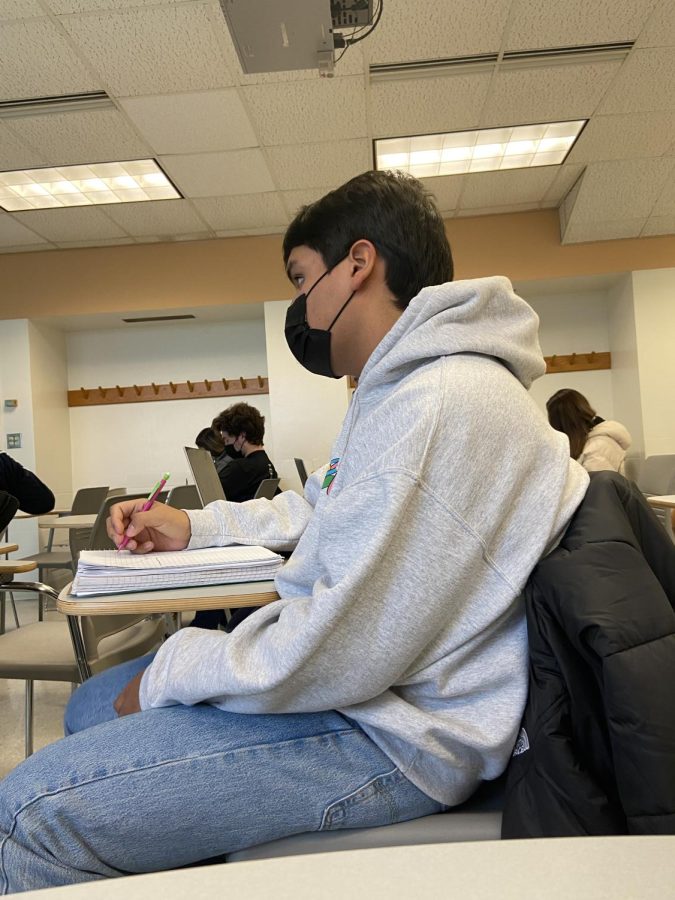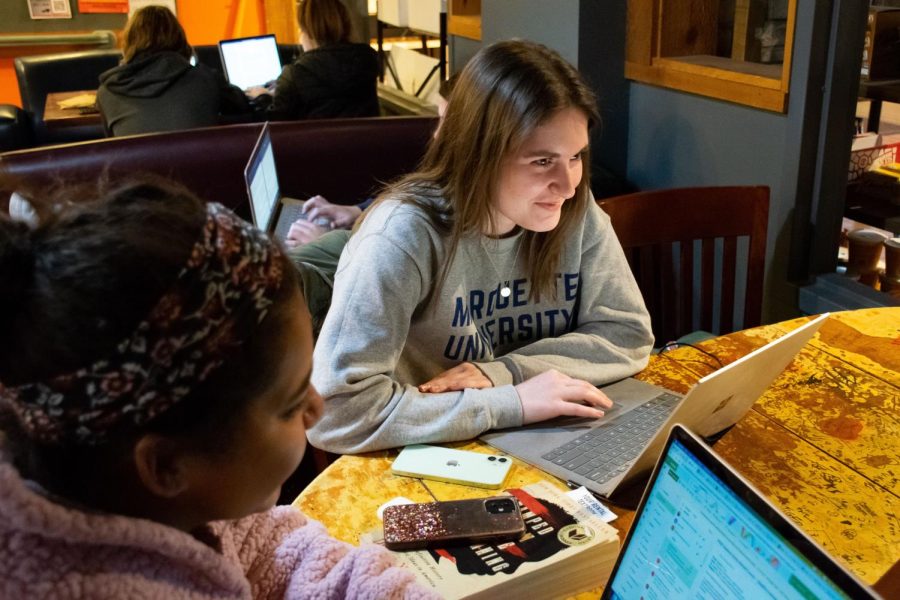When Amy Newman came to the difficult decision to move her mother into an assisted living facility, she felt completely alone.
“There is no continuity of care for older adults,” Newman, assistant professor of nursing at Marquette, says. “I feel like I’m on an island.”
Even before the coronavirus outbreak, Newman struggled to find the right living arrangements for her mother. Marilyn Rasmussen, 73, initially resided in an assisted living facility, that cares for seniors who can no longer live alone but can maintain an active lifestyle. This differs from skilled nursing facilities, which are for seniors who require medical assistance and 24-hour care.
But in the late winter of 2019, Newman’s mother experienced a number of falls. She was taken to the hospital and, during that time, she experienced a “significant alteration in her mental capacity,” Newman says.
After receiving treatment for hallucinations, Rasmussen was discharged to a senior behavioral unit. She stayed for one month. As she prepared to return to her assisted living facility, the family received troubling news: the facility no longer felt able to care for her.
“They didn’t think she could safely go back to her apartment, and they didn’t feel like she was a candidate for their memory care,” Newman says. “So we were in a little bit of a bind.”
Then the coronavirus “really hit,” and with it came the complete restructuring of communal life. State governments imposed pandemic guidelines, including a mandatory stay-at-home order.
Newman would have to find a new home for her mother without even touring facilities in-person, a difficult task with coronavirus cases rising.
Five characteristics may significantly increase the probability of having a coronavirus case at a facility: larger facility size, urban location, greater percentage of African American residents, non-chain status and state in which the facility is located, according to the American Geriatrics Society.
“In today’s day and age of COVID-19, most families will simply need to ask lots of questions on the telephone,” Stacy Barnes, director of the Wisconsin Geriatric Education Center, says.
While conducting online research, Newman quickly found her options were limited.
“All the long-term care facilities, all the residentials and all the senior living communities were pretty much shut down and not accepting new patients,” Newman says.
Newman was eventually able to find a hospital in Milwaukee that was willing to accept Rasmussen into their memory care program.
“We feel very fortunate for the place she’s at, but … we just didn’t have any options, honestly,” Newman says.
Due to the frailty of older populations, nursing homes are susceptible to serious and potentially fatal coronavirus outbreaks. Internal operations at facilities drastically shifted to accommodate new safety practices. Most have adopted a no-visitation policy, and tours were suspended, as outlined by the Center for Disease Control and Prevention and the Wisconsin Department of Health Services.
Franciscan Villa, located in South Milwaukee, is one such long-term care facility impacted by these changing guidelines. The first day on the job at Franciscan Villa was an immediate jump into the middle of communication about the coronavirus for Christine Wasserman, director of communications. Franciscan Villa is part of the larger Catholic Health Initiatives (CHI) Living Communities, with 13 campuses among seven states, which made communication a challenge while trying to coordinate with different state‘s officials, says Wasserman.
Franciscan Villa is one of 15 long-term care communities that have been under investigation for cases of the coronavirus, according to the Wisconsin DHS. To be under investigation, a facility must have two or more confirmed cases among residents or staff, Wisconsin DHS also notes.
Communication about the number of cases has been difficult, Wasserman says. Numbers have to be reported to public health officials, but by the time the numbers from one day are processed and released, the number of cases at Franciscan Villa might have already changed.
“It becomes a sticky wicket, if you will, because … people sometimes become frustrated and the misperception is that we are not being transparent,” says Wasserman. “That we’re trying to, if you will, hide information. That’s not the case at all. We just want to make sure that we are respecting the jurisdiction of public health officials.”
Like the speed with which she was wrapped up into the coronavirus communications, Wasserman says as soon as the seriousness of the virus became clear and guidelines were released, Franciscan Villa followed all suggestions by public health officials. Universal mask wearing, restricted visitation, no community dining, no group activities and isolation procedures for suspected and confirmed cases are just some of the changes made to daily routines at Franciscan Villa.
Wasserman says that Franciscan Villa was proactive from the beginning and that, procedurally, it moved along like clock-work.
Because older adults are at high risk for infection and mortality, the tendency for most institutions is to ensure residents are self-isolating, Barnes says. Shared activities such as movie nights, religious services and mealtimes have become smaller or even completely solitary events.
“All of those (activities) are great to promote engagement and interaction among the residents,” Newman says. “But in the context of a pandemic, it potentially supports the spread of the virus.”
While it is important that older adults are able to mitigate the risk of infection through isolation, residents must also remain physically active and socially engaged, Barnes says. This results in a dangerous balancing act.
Communicating these changes with families has been one of the hardest parts, emotionally, says Stephanie Chedid, CEO and president of Luther Manor, a long-term care facility in Wauwatosa. She recalls a family that was traveling out of town to visit the children’s grandmother in the rehabilitation center just as the seriousness of COVID-19 was becoming clearer. They were supposed to stay in one of Luther Manor’s guest units. As the family was driving, the facility went into lockdown, restricting the family from seeing the grandmother and from staying at Luther Manor. Unable to reach the family, Chedid says it was not until the family members arrived at the property that they were notified of the sudden change.
“That was one of the hardest conversations I’ve had to have in a long time,” says Chedid.
There are other psychological impacts of extended isolation, Barnes says.
“Family and friends provide social connectedness that not only gives joy to our lives, but also helps address issues like depression, anxiety … and dementia,” Barnes says. “Can we expect residents to give up human touch or seeing family members?”
Isolation is especially demoralizing for her mother, Newman says.
“She feels like she’s losing some of her mental capacity … because of a lack of interaction,” Newman says. “I actually see her mentally and physically deteriorating.”
Newman has not been able to visit Rasmussen in person for over five months. The facility does allow window visits and telecommunication, however. Newman has tried both, and neither can replace the overwhelming power of touch, she says.
“It’s not the same as being able to give your mom a hug or to give her a tissue when she starts crying,” Newman says.
To help maintain that connection with loved ones and other residents, Franciscan Villa has brought in tablets and laptops to allow residents to video chat with loved ones and has been streaming such things as chapel services.
“I think for all of us it’s just heartbreaking that we know we’re doing the right thing,” says Wasserman. “What we need to do, we must do, to safeguard our residents and yet it is so heartbreaking because you see elderly, frail people who don’t have direct access to their loved ones.”
Some residents, Wasserman says, depending on their mental ability, are even left wondering why loved ones haven’t been there to visit.
Barnes echoes Wasserman’s sentiment, adding that even when residents are able to visit loved ones virtually, the technology itself can be difficult for those with memory trouble.
“(The resident) may not be engaged with the family member, or they may be confused about why the family members are on screen as opposed to there in person,” Barnes says. “Using a video conferencing format works best if people are cognitively intact.”
Newman says she is fortunate that her mother remembers who she is. But other families struggle to maintain a connection virtually.
“I worry about a friend of mine who has a mom in a facility in Iowa,” she says. “She has Alzheimer’s and is already struggling to remember who my friend is.”
Families are being asked to resolve an ethical dilemma, Barnes says.
“Do they prefer to increase the risk of their loved one for COVID-19 by conducting in-person visits, by actually hugging them? It’s not recommended, but maybe they’d prefer to take that risk if it would lead to a higher quality of life in the short term,” Barnes says.
While struggling with this dichotomy, Newman found herself responsible for communicating with each subspecialist involved in the treatment of Rasmussen.
“My mom has a neurologist to manage her Parkinson’s. She has a geriatric psychiatrist that she works with. Then she has her primary care provider,” Newman says. “They don’t necessarily communicate well.”
Newman’s geriatric psychiatry appointments are exclusively over the phone, but the system does not have the capacity for both Newman and Rasmussen to be on the call at the same time.
For Newman to get a recap from those virtual visits, she must engage in a complex game of telephone.
“The last time my mom met with (the psychiatrist), he called me after the visit to talk about a plan and I missed the call,” Newman says. “I called his office back and they had nurses and other officials that tried to answer all my questions before I could actually get to the psychiatrist.”
But Newman says she never was able to talk to the psychiatrist, because it was difficult to contact him directly. The miscommunication makes her feel uncertain about what care her mother is receiving.
“It’s just tricky. This is tricky,” Newman says.
What poses a bigger issue for some facilities is handling questions and coverage from news outlets, suggests Chedid.
Like Franciscan Villa, Luther Manor has also seen coronavirus cases in the facility. The first one came in early March, with a resident that had acquired it from a doctor’s appointment the day before Luther Manor had gone into lockdown, says Chedid. Within a few weeks, the resident was healthy and able to return to Luther Manor. She is doing well and no other residents contracted the coronavirus from her.
Luther Manor learned of the resident’s illness at 1:30 a.m., created a plan regarding her recovery by 2 a.m. and devised a 20-point checklist on a notification process by morning. Over the next 20 hours, Luther Manor worked with the Department of Health. In addition to each of these steps, the facility also had to create a press release to get ahead of any news coverage.
While she understands that reporters are doing their job, Chedid says she feels that the skilled nursing world has been demonized, and efforts to clarify the situation take away from caring for residents. She emphasizes that just because a facility has an outbreak it doesn’t mean it’s a bad facility and added that the key is whether you are able to stop the spread.
“We don’t want to rush to judgement,” Barnes echoes. “It does not mean (health practitioners) are delivering poor care, it means these facilities are being challenged by the disease itself.”
Chedid says that because Luther Manor is experienced and have protocol already in place for contagious illnesses, the procedure for handling cases and communication allowed for a smooth handling of the first case of coronavirus. While the coronavirus and guidelines surrounding it continue to change, Chedid says it has become routine.
Although guidelines remain fluid, they are not arbitrary.
Luther Manor began putting guidelines and communication into action in early March. A 20-person COVID-19 response team was quickly assembled, dedicating their time to daily conference calls, reading notices and problem solving in order to ensure everyone was up to speed on every change, says Chedid.
“When we first got together as an executive team I said, ‘you know, what can we control right now?’” says Chedid. “‘We have no control over this virus, have no control about rules that are going to be coming down on us, certainly there are a lot of other things, but the one thing we can control is communication.’”
Communication is imperative because so many have felt that they were in the dark, says Chedid. She has focused on nightly family subscription emails, an updated daily hotline, messages at the beginnings of calls and a new website that gets continually updated.
Communication with staff has also been prioritized. Chedid says she began sending out updates to staff on a weekly basis, then increased frequency of communication to every other day.
Chedid says she can’t emphasize enough the remarkable work of the employees who are putting themselves at risk every day, being flexible in, and often adjusting, their roles within Luther Manor.
The greatest risk to older adults, however, remains the staff that come in and out each day, Barnes says. Therefore, caregivers must be both attentive and health-conscious by practicing social distancing, Barnes says.
“The virus is likely to infect the majority of nursing home staff and residents due to the highly vulnerable population and congregate living situation,” Barnes says. “The concern is increasing daily.”
As people continue to socialize in larger numbers, return to work and go to restaurants, experts worry that asymptomatic spreaders of the coronavirus will infect older adults, Barnes says.
Morgan Holt, a senior in the College of Nursing, is no stranger to safety precautions. Holt has taken five COVID-19 tests as part of a routine mandated by her work, she says.
Each morning before she clocks in to work at Saint Camillus nursing home, Holt gets her temperature checked. She then answers questions about coronavirus symptoms. Both of these safety measures, she says, are entirely expected, considering the population she works with.
“It’s kind of unique because each week it feels like there’s a new COVID-19 test we need to take,” Holt says, referencing the proliferation of new and moderated safety protocols at Saint Camillus.
The coronavirus pandemic may force the long-term care industry to change permanently. Aside from safety guidelines, Barnes says she hopes more attention is paid to raising wages and increasing benefits of healthcare practitioners.
The John Hartford Foundation, American Geriatric Society and the Institute for Healthcare Improvement recently identified the “Four M’s” — mobility, mentation, medication and matters most — of age-friendly healthcare practices.
“This is not unique to long-term care facilities,” Barnes says. “This is really about good geriatric care for any person.”
Newman says she hopes her mother will regain mental acuity as society continues to reopen, but she admits it will be “a long time coming.”
“I don’t know how we will recover from this,” Newman says. “I think some older adults won’t.”
This story was written by Lelah Byron and Amanda Parrish. They can be reached at [email protected] and [email protected].









